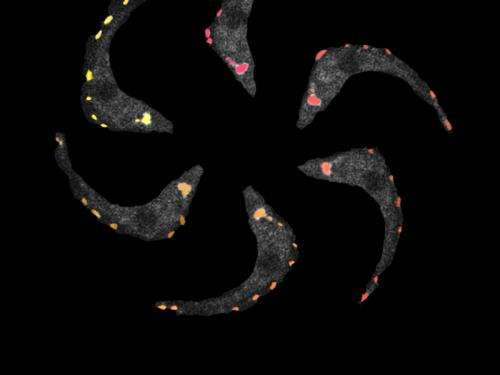A molecular delivery service

Tiny hair-like structures (cilia) are found on the surface of most cells. Cilia are responsible for the locomotion of cells (e.g. sperm cells), they process external signals and coordinate the correct arrangement of the inner organs during the development of an organism. For proper assembly and function of cilia, they need to be supplied with the appropriate building blocks.
Scientists at the Max Planck Institute of Biochemistry (MPIB) in Martinsried near Munich, Germany, now identified the mechanism of how Tubulin, the main building block of cilia, is transported within the cilium.
"Defects in cilia cause numerous diseases that affect millions of people worldwide," says Sagar Bhogaraju, scientist at the MPI of Biochemistry.
The results now published in the journal Science could help to understand and potentially prevent these diseases.
Although cilia fulfill various tasks, they all have a similar structure: They are only five to ten micrometers (0.0005 to 0.001 centimeters) long and are located on the surface of eukaryotic cells. About 600 different ciliary proteins are synthesized inside the cell and then transported into the cilium. Disruption of this transport system, which scientists call intraflagellar transport (IFT), can lead to errors during the assembly of the cilia and thus cause diseases resulting in mental and physical symptoms. Mistakes in ciliary function can for example cause a "situs inversus", a condition where the left/right arrangement of the inner organs in the body is reversed.
Even though the importance of the intraflagellar transport (IFT) and the cilium to human health has been known for a long time, a structural and mechanistic understanding of IFT has been missing so far. Scientists from the research group "Intraflagellar Transport" headed by Esben Lorentzen now succeeded in identifying the transport mechanism of the key protein Tubulin. It is the most abundant protein in the cilium and forms its backbone. "We found that the two proteins IFT74 and IFT81 work together to form a tubulin-binding module," says Sagar Bhogaraju. When the researchers disturbed the binding of IFT74 and -81 to tubulin in human cells, it had severe impact on the formation of the cilia. "Our results provide the first glimpse into the assembly of the cilium at the molecular level," says the biochemist.
More information: Bhogaraju, S., et al. Molecular Basis of Tubulin Transport within the Cilium by IFT74 and IFT81, Science, August 30, 2013. DOI: 10.1126/science.1240985
Journal information: Science
Provided by Max Planck Society



















